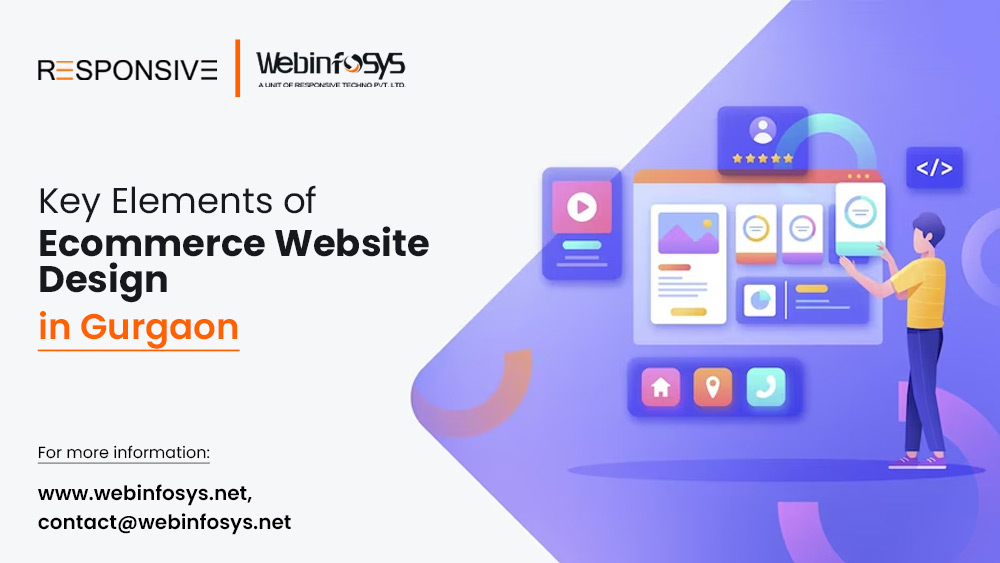Key Elements of Ecommerce Website Design in Gurgaon
This article will explore the key elements of user-friendly navigation and information architecture in the context of e-commerce website design in Gurgaon, focusing on the importance of Ecommerce Website Design company in Gurgaon.

In today's digital landscape, where online shopping has become the norm, it is essential for e-commerce websites to provide a seamless and enjoyable browsing experience. User-friendly navigation and well-structured information architecture play a vital role in guiding visitors through the website and helping them find the products or information they seek. In the bustling city of Gurgaon, with its thriving e-commerce industry, optimizing these elements becomes even more critical. This article will explore the key elements of user-friendly navigation and information architecture in the context of e-commerce website design in Gurgaon, focusing on the importance of Ecommerce Website Design company in Gurgaon.
Understanding User-Friendly Navigation
User-friendly navigation refers to the ease with which users can browse through different sections of a website. It involves intuitive menu structures, clear labels, and logical organization of content. A well-designed navigation system ensures that users can find what they are looking for quickly and effortlessly, reducing frustration and increasing engagement.
Importance of Clear Information Architecture
Information architecture involves organizing and structuring content in a logical and user-friendly manner. It encompasses the arrangement of product categories, subcategories, filters, and search functionalities. A clear information architecture enables visitors to navigate through the website with ease, leading to a more enjoyable and productive user experience.
Strategic Placement of Navigation Elements
Placing navigation elements strategically is essential for effective website design. The primary navigation menu should be prominently displayed and easily accessible, preferably at the top of the page. It should use clear and concise labels that accurately represent the content within each section.
Responsive Design for Mobile Users
With the increasing use of mobile devices for online shopping, it is crucial to ensure that e-commerce websites are responsive and mobile-friendly. The navigation and layout should adapt seamlessly to different screen sizes, allowing mobile users to navigate effortlessly.
Optimizing Page Load Speed
Page load speed is a critical factor in user experience and search engine optimization. Slow-loading pages can lead to high bounce rates and frustrated users. Optimizing images, minimizing code, and leveraging caching techniques are some strategies to improve page load speed.
Enhancing Search Functionality
A robust search functionality is indispensable for e-commerce websites. It enables users to find products based on specific criteria, such as keywords, categories, or attributes. Implementing advanced search features, such as auto-suggestions and filters, enhances the user experience and makes the search process more efficient.
Streamlining Checkout Process
A smooth and streamlined checkout process is vital for converting visitors into customers. Simplifying the steps required to complete a purchase, providing clear instructions, and offering guest checkout options can significantly improve the conversion rate and reduce cart abandonment.
Utilizing Breadcrumbs for Easy Navigation
Breadcrumbs are navigational aids that show the user's current location within the website's hierarchy. They provide a visual trail back to previous pages and help users understand where they are and how they arrived there. Breadcrumbs enhance the navigation and improve the overall user experience.
Incorporating Visual Hierarchy
Visual hierarchy involves arranging elements on a webpage in a way that guides users' attention and prioritizes important information. Proper use of headings, subheadings, font sizes, colors, and contrast can help users quickly grasp the structure and content hierarchy of the website.
Implementing Intuitive Filters and Sorting Options
E-commerce websites often offer a wide range of products. Implementing intuitive filters and sorting options allows users to refine their search results based on specific criteria, such as price, size, color, or brand. This functionality simplifies the product selection process and improves user satisfaction.
Including Call-to-Action Buttons
Strategically placed call-to-action (CTA) buttons prompt users to take specific actions, such as adding items to the cart, subscribing to newsletters, or initiating the checkout process. Well-designed and prominent CTAs guide users through the conversion funnel and drive desired user actions.
Leveraging User Feedback and Analytics
Collecting and analyzing user feedback and website analytics provides valuable insights into user behavior, preferences, and pain points. By leveraging this data, e-commerce businesses can identify areas for improvement in navigation and information architecture, resulting in an optimized user experience.
Ensuring Accessibility for All Users
An inclusive website design is essential for ensuring that all users, including those with disabilities, can access and navigate the website easily. Following accessibility guidelines and incorporating features like alternative text for images and keyboard navigation options helps create an inclusive user experience.
Conclusion
Creating a user-friendly navigation system and implementing a clear information architecture are crucial aspects of e-commerce website design in Gurgaon. By optimizing these elements, businesses can provide a seamless browsing experience, increase user engagement, and ultimately drive conversions. Investing in user-centric design principles and continuously refining navigation based on user feedback will position e-commerce websites for success in the competitive Gurgaon market. And if you are new to business and willing to implement this for your website then the best place to visit is Webinfosys. They are one of the most trustworthy and reputable e-commerce Website Designing Company in Gurgaon.






